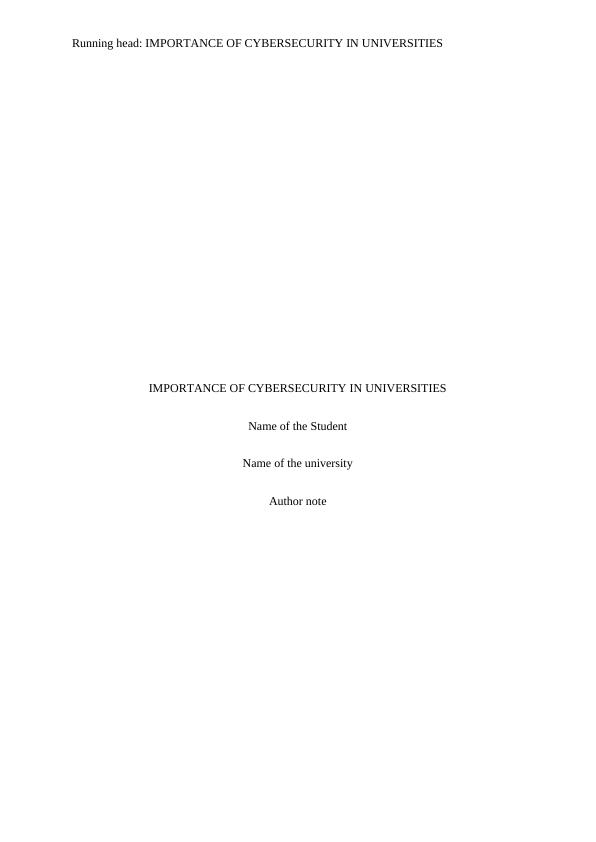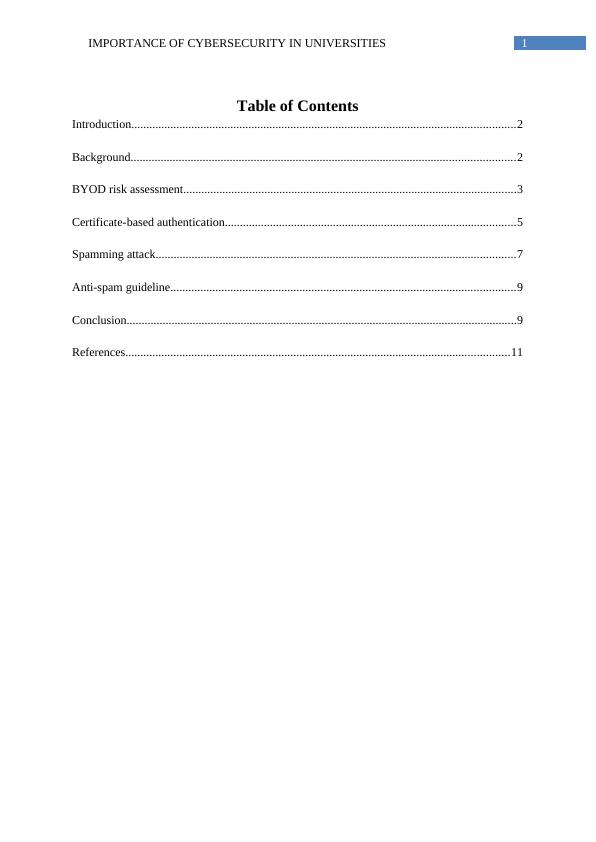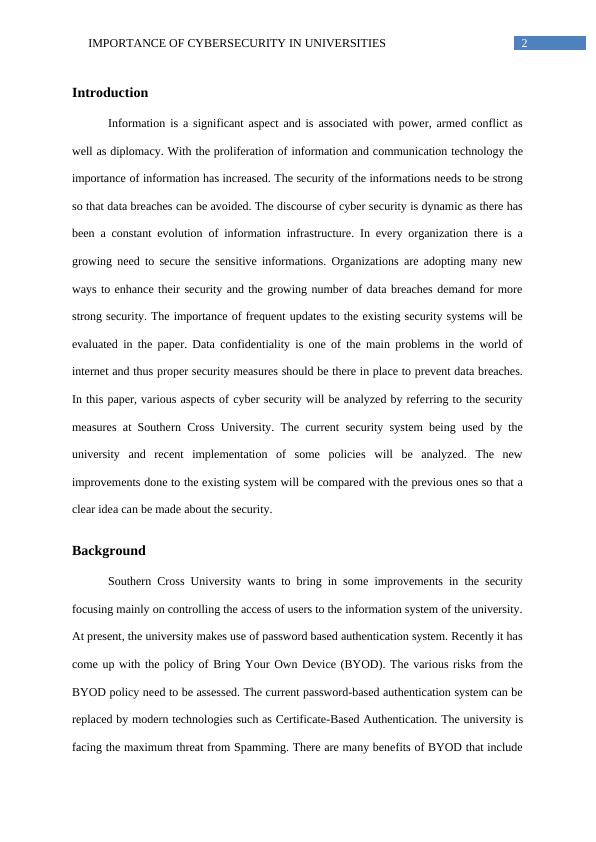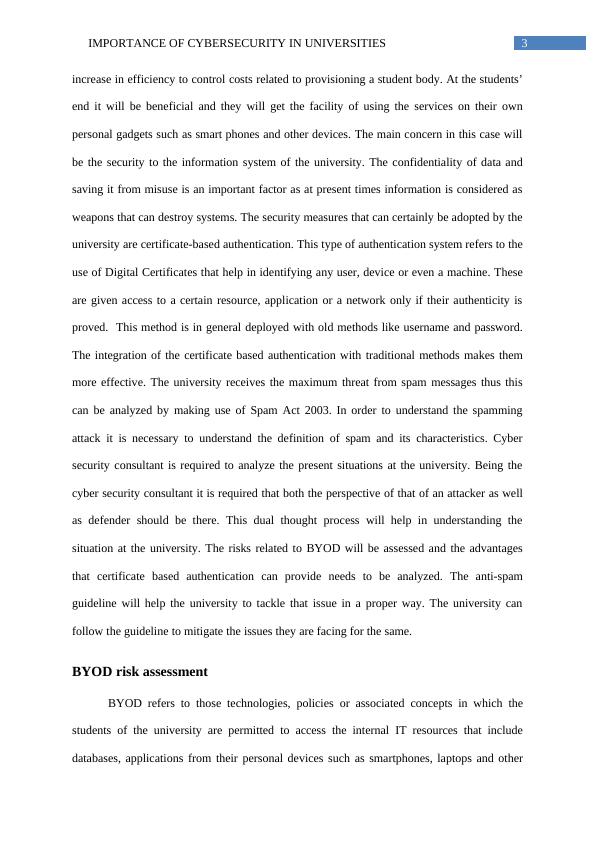Why is cybersecurity important for the education sector?
Added on 2022-08-17
14 Pages3669 Words11 Views
Running head: IMPORTANCE OF CYBERSECURITY IN UNIVERSITIES
IMPORTANCE OF CYBERSECURITY IN UNIVERSITIES
Name of the Student
Name of the university
Author note
IMPORTANCE OF CYBERSECURITY IN UNIVERSITIES
Name of the Student
Name of the university
Author note

1IMPORTANCE OF CYBERSECURITY IN UNIVERSITIES
Table of Contents
Introduction................................................................................................................................2
Background................................................................................................................................2
BYOD risk assessment...............................................................................................................3
Certificate-based authentication.................................................................................................5
Spamming attack........................................................................................................................7
Anti-spam guideline...................................................................................................................9
Conclusion..................................................................................................................................9
References................................................................................................................................11
Table of Contents
Introduction................................................................................................................................2
Background................................................................................................................................2
BYOD risk assessment...............................................................................................................3
Certificate-based authentication.................................................................................................5
Spamming attack........................................................................................................................7
Anti-spam guideline...................................................................................................................9
Conclusion..................................................................................................................................9
References................................................................................................................................11

2IMPORTANCE OF CYBERSECURITY IN UNIVERSITIES
Introduction
Information is a significant aspect and is associated with power, armed conflict as
well as diplomacy. With the proliferation of information and communication technology the
importance of information has increased. The security of the informations needs to be strong
so that data breaches can be avoided. The discourse of cyber security is dynamic as there has
been a constant evolution of information infrastructure. In every organization there is a
growing need to secure the sensitive informations. Organizations are adopting many new
ways to enhance their security and the growing number of data breaches demand for more
strong security. The importance of frequent updates to the existing security systems will be
evaluated in the paper. Data confidentiality is one of the main problems in the world of
internet and thus proper security measures should be there in place to prevent data breaches.
In this paper, various aspects of cyber security will be analyzed by referring to the security
measures at Southern Cross University. The current security system being used by the
university and recent implementation of some policies will be analyzed. The new
improvements done to the existing system will be compared with the previous ones so that a
clear idea can be made about the security.
Background
Southern Cross University wants to bring in some improvements in the security
focusing mainly on controlling the access of users to the information system of the university.
At present, the university makes use of password based authentication system. Recently it has
come up with the policy of Bring Your Own Device (BYOD). The various risks from the
BYOD policy need to be assessed. The current password-based authentication system can be
replaced by modern technologies such as Certificate-Based Authentication. The university is
facing the maximum threat from Spamming. There are many benefits of BYOD that include
Introduction
Information is a significant aspect and is associated with power, armed conflict as
well as diplomacy. With the proliferation of information and communication technology the
importance of information has increased. The security of the informations needs to be strong
so that data breaches can be avoided. The discourse of cyber security is dynamic as there has
been a constant evolution of information infrastructure. In every organization there is a
growing need to secure the sensitive informations. Organizations are adopting many new
ways to enhance their security and the growing number of data breaches demand for more
strong security. The importance of frequent updates to the existing security systems will be
evaluated in the paper. Data confidentiality is one of the main problems in the world of
internet and thus proper security measures should be there in place to prevent data breaches.
In this paper, various aspects of cyber security will be analyzed by referring to the security
measures at Southern Cross University. The current security system being used by the
university and recent implementation of some policies will be analyzed. The new
improvements done to the existing system will be compared with the previous ones so that a
clear idea can be made about the security.
Background
Southern Cross University wants to bring in some improvements in the security
focusing mainly on controlling the access of users to the information system of the university.
At present, the university makes use of password based authentication system. Recently it has
come up with the policy of Bring Your Own Device (BYOD). The various risks from the
BYOD policy need to be assessed. The current password-based authentication system can be
replaced by modern technologies such as Certificate-Based Authentication. The university is
facing the maximum threat from Spamming. There are many benefits of BYOD that include

3IMPORTANCE OF CYBERSECURITY IN UNIVERSITIES
increase in efficiency to control costs related to provisioning a student body. At the students’
end it will be beneficial and they will get the facility of using the services on their own
personal gadgets such as smart phones and other devices. The main concern in this case will
be the security to the information system of the university. The confidentiality of data and
saving it from misuse is an important factor as at present times information is considered as
weapons that can destroy systems. The security measures that can certainly be adopted by the
university are certificate-based authentication. This type of authentication system refers to the
use of Digital Certificates that help in identifying any user, device or even a machine. These
are given access to a certain resource, application or a network only if their authenticity is
proved. This method is in general deployed with old methods like username and password.
The integration of the certificate based authentication with traditional methods makes them
more effective. The university receives the maximum threat from spam messages thus this
can be analyzed by making use of Spam Act 2003. In order to understand the spamming
attack it is necessary to understand the definition of spam and its characteristics. Cyber
security consultant is required to analyze the present situations at the university. Being the
cyber security consultant it is required that both the perspective of that of an attacker as well
as defender should be there. This dual thought process will help in understanding the
situation at the university. The risks related to BYOD will be assessed and the advantages
that certificate based authentication can provide needs to be analyzed. The anti-spam
guideline will help the university to tackle that issue in a proper way. The university can
follow the guideline to mitigate the issues they are facing for the same.
BYOD risk assessment
BYOD refers to those technologies, policies or associated concepts in which the
students of the university are permitted to access the internal IT resources that include
databases, applications from their personal devices such as smartphones, laptops and other
increase in efficiency to control costs related to provisioning a student body. At the students’
end it will be beneficial and they will get the facility of using the services on their own
personal gadgets such as smart phones and other devices. The main concern in this case will
be the security to the information system of the university. The confidentiality of data and
saving it from misuse is an important factor as at present times information is considered as
weapons that can destroy systems. The security measures that can certainly be adopted by the
university are certificate-based authentication. This type of authentication system refers to the
use of Digital Certificates that help in identifying any user, device or even a machine. These
are given access to a certain resource, application or a network only if their authenticity is
proved. This method is in general deployed with old methods like username and password.
The integration of the certificate based authentication with traditional methods makes them
more effective. The university receives the maximum threat from spam messages thus this
can be analyzed by making use of Spam Act 2003. In order to understand the spamming
attack it is necessary to understand the definition of spam and its characteristics. Cyber
security consultant is required to analyze the present situations at the university. Being the
cyber security consultant it is required that both the perspective of that of an attacker as well
as defender should be there. This dual thought process will help in understanding the
situation at the university. The risks related to BYOD will be assessed and the advantages
that certificate based authentication can provide needs to be analyzed. The anti-spam
guideline will help the university to tackle that issue in a proper way. The university can
follow the guideline to mitigate the issues they are facing for the same.
BYOD risk assessment
BYOD refers to those technologies, policies or associated concepts in which the
students of the university are permitted to access the internal IT resources that include
databases, applications from their personal devices such as smartphones, laptops and other

End of preview
Want to access all the pages? Upload your documents or become a member.
Related Documents
Cybersecurity Threats and Anti-Spam 3 CONCLUSIONS 4 INTRODUCTION Cybersecurity Threats and Anti-Spam 3 CONCLUSION 3 REFERENCES 4 INTRODUCTION Cybersecurity Threats and Anti-Spam 3 CONCLUSION 3 REFERENlg...
|7
|1670
|122
Risk Assessment of Southern Cross Universitylg...
|13
|2466
|317
BYOD Policy Threats and Security Strategies for Cybersecuritylg...
|11
|2820
|426
Solutions of Cybersecurity Assignmentlg...
|9
|2005
|320
Cyber Security - Assignmentlg...
|14
|3398
|36
Cyber Security: Risks and Solutions for South Cross Universitylg...
|12
|2052
|467
